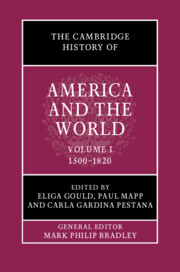Book contents
- The Cambridge History of America and the World
- The Cambridge History of America and the World
- The Cambridge History of America and the World
- Copyright page
- Contents
- Figures
- Maps
- Contributors to Volume I
- General Introduction: What is America and the World?
- Introduction: What Does America and the World “Mean” before 1825?
- Part I Geographies
- Part II People
- 5 Jews, Muslims, Pagans, and America
- 6 Statelessness, Subjecthood, and the Early American Past
- 7 Mobility and the Movement of Peoples
- 8 How Native Americans Shaped Early America
- Part III Empires
- Part IV Circulation/Connections
- Part V Institutions
- Part VI Revolutions
- Index
5 - Jews, Muslims, Pagans, and America
from Part II - People
Published online by Cambridge University Press: 12 November 2021
- The Cambridge History of America and the World
- The Cambridge History of America and the World
- The Cambridge History of America and the World
- Copyright page
- Contents
- Figures
- Maps
- Contributors to Volume I
- General Introduction: What is America and the World?
- Introduction: What Does America and the World “Mean” before 1825?
- Part I Geographies
- Part II People
- 5 Jews, Muslims, Pagans, and America
- 6 Statelessness, Subjecthood, and the Early American Past
- 7 Mobility and the Movement of Peoples
- 8 How Native Americans Shaped Early America
- Part III Empires
- Part IV Circulation/Connections
- Part V Institutions
- Part VI Revolutions
- Index
Summary
In 1492 Europeans added another category to the peoples and religions of which they were in varying degrees aware: they knew of Catholic Christians in Western Europe, Orthodox Christians in Eastern Europe, Jews in those lands that had not expelled them (as Spain did that year), Muslims in North Africa, the Balkans, and the Middle East. They had heard of Buddhists and followers of other Eastern faiths following thirteenth-century expeditions by missionaries and merchants to the Mongol court in the Far East. They knew of “pagans,” those who appeared to worship many gods, a few remnants of whom could still be found in remote corners of Northeastern Europe, though the pagan rulers of Lithuania had converted to Catholicism a century earlier. They added the pagan Canary Islanders to this list as the Canary archipelago was explored from the mid-fourteenth century onwards; Grand Canary fell to its Spanish conquerors in 1483, though the conquest of the islands was only completed in 1496, with the capitulation of Tenerife.
- Type
- Chapter
- Information
- The Cambridge History of America and the World , pp. 117 - 138Publisher: Cambridge University PressPrint publication year: 2022

